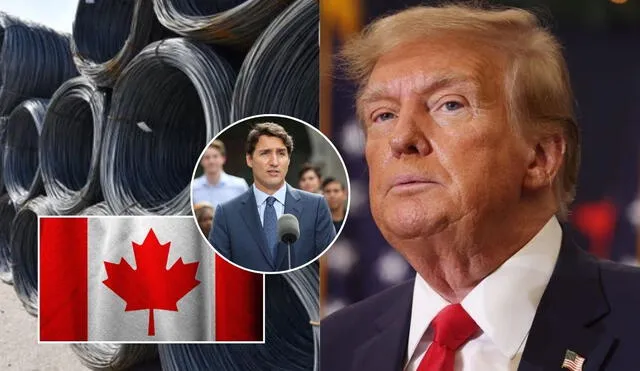Trump trade policy: U.S. imposes double tariffs on Canadian steel and aluminum
Now the tariffs will be 50% and will come into force this Wednesday. After the announcement, the main Wall Street indices fell in another volatile day for the markets due to the ups and downs of the trade war.

On March 11, President Donald Trump revealed plans to impose double tariffs on Canadian steel and aluminum, escalating trade tensions between the two nations. Just one day before new tariffs were set to take effect, Trump declared an additional 25% levy, bringing the total tariff on Canadian steel and aluminum imports to a staggering 50%.
In the midst of the tariff war initiated by the leader of the White House, the new measure comes after the response of Canada, which last week announced 25% tariffs on its neighboring country with “immediate effect.” This decision, announced via Trump’s social media platform, has sent shockwaves through industries, markets, and diplomatic circles. Here’s a breakdown of what’s happening and why it matters.
Trump trade policy: Why the sudden tariff hike?
Trump’s move comes in response to Ontario’s recent imposition of a 25% surcharge on electricity exports to Minnesota, Michigan, and New York. Ontario Premier Doug Ford implemented the surcharge as a retaliatory measure against Trump’s repeated tariff threats.
In his post, Trump framed the tariff hike as a necessary step to protect American industries and national security. He also hinted at declaring a “National Emergency on Electricity” to address the impact of Ontario’s surcharge, though details remain unclear.
Economic fallout following double tariffs
The announcement has sparked swift backlash from Canada and unease among U.S. businesses. Here’s a quick look at the reactions:
- Canada: Premier Doug Ford vowed to maintain the electricity surcharge until U.S. tariffs are permanently lifted.
- U.S. industries: Manufacturers fear rising costs, while domestic steel producers welcome the move.
- Stock markets: Economic uncertainty has led to significant declines, with the S&P 500 down over 7% since Trump’s inauguration.
The tariffs could disrupt supply chains, increase prices for American consumers, and strain the U.S.-Canada trade relationship, which is already under pressure.
What’s next for U.S.-Canada relations?
Trump’s tariff policy has been a hallmark of his presidency, but this latest move raises questions about the future of U.S.-Canada trade. Canada is the largest exporter of steel and aluminum to the U.S., and a 50% tariff could have severe economic repercussions for both nations.
Adding to the tension, Trump once again floated the idea of Canada becoming a U.S. state, a proposal Canadian leaders have repeatedly rejected. While the suggestion seems far-fetched, it underscores the unpredictable nature of Trump’s trade strategy.
The bigger picture: Economic uncertainty under Trump
The tariffs are part of Trump’s broader effort to boost U.S. manufacturing and reduce reliance on foreign goods. However, the rapid shifts in policy have created instability, contributing to declining consumer confidence and spending.
As Trump prepares to address the Business Roundtable, a group of top U.S. CEOs, many are hoping for clarity on his economic goals. For now, one thing is certain: the U.S.-Canada trade relationship is entering uncharted territory.












